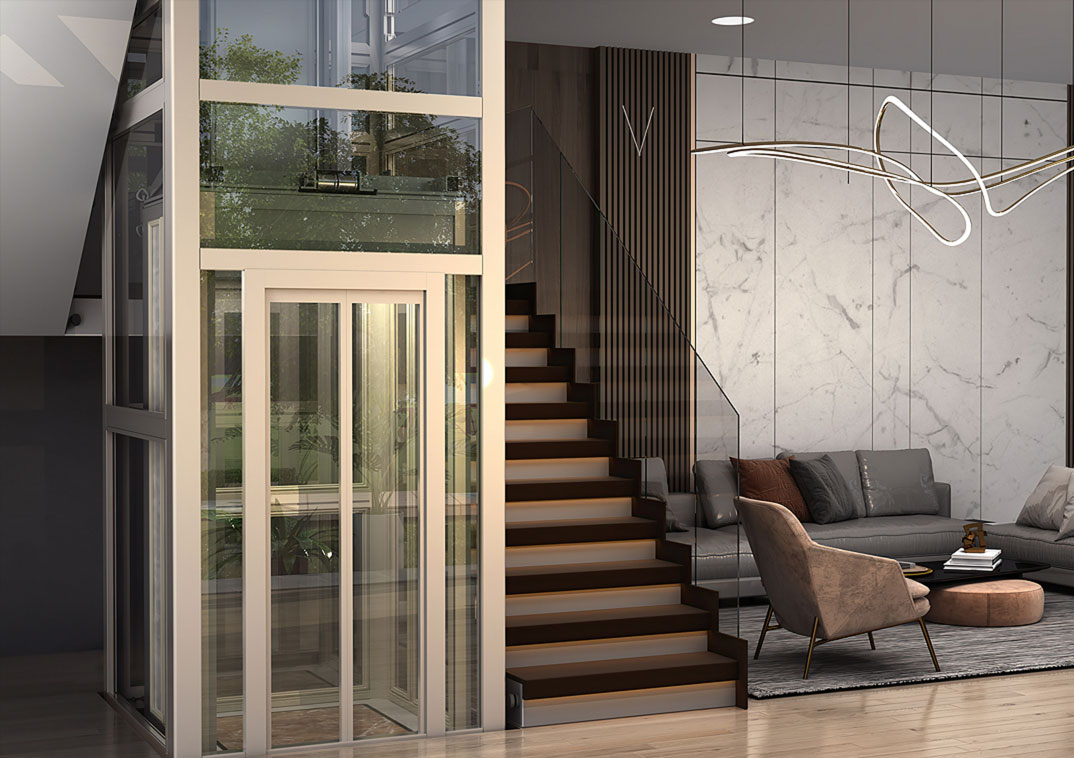The air circulation and ventilation system of villa elevators is a very important part of elevator design, especially when used for a long time in a closed space. Good ventilation can ensure air quality, avoid the accumulation of odor and moisture, and improve the comfort of users. The air circulation and ventilation design of villa elevators usually needs to be optimized according to the type of elevator, installation location and specific needs of the building. Here are some common air circulation and ventilation system design points:
Some villa elevators are designed to add windows or light-transmitting areas on the top or side of the car so that natural air can be introduced when the elevator is running, especially for elevators installed in stairwells or open spaces. Window design also helps to provide external views and enhance the visual experience of the elevator.
Some elevator car designs use vents or mesh structures to ensure that air can flow freely in the elevator. In particular, small holes are set at the top and bottom of the elevator to help air circulation and avoid air stagnation.
Modern villa elevators are usually equipped with a built-in small fan system to circulate air through the top or side walls of the elevator. The fan keeps the air flowing by sucking air and pushing it into the elevator to prevent air stagnation in the elevator. This ventilation system is usually equipped with a low-noise design to ensure that the user experience is not affected.
Some high-end villa elevators are equipped with intelligent temperature control systems that can automatically adjust the fan speed according to the temperature and humidity in the elevator. Such systems can sense the air quality inside the elevator in real time, automatically start ventilation or air purification functions, and keep the air fresh.
Some high-end villa elevators are equipped with HEPA air filters, especially in areas with poor air quality or in families with special needs (such as the elderly, allergic people, etc.). HEPA filters can effectively filter out dust, pollen, bacteria and other harmful substances in the air to ensure that the air in the elevator is fresh and healthy.
Some villa elevators are equipped with negative ion air purification devices that can release negative ions, refresh the air in the elevator and remove odors. Negative ions help remove pollutants from the air and keep the air inside the elevator fresh.

In an environment with high humidity, moisture in the elevator may affect the air quality and the durability of the equipment. Therefore, some villa elevator designs use dehumidification systems to help reduce moisture in the elevator car and prevent mold growth. This system usually works in conjunction with an air circulation system.
Some villa elevators are equipped with automatic humidity sensors, which automatically start or shut down the dehumidification function according to the detected air humidity. This allows the internal environment of the elevator to be intelligently adjusted according to demand to avoid over-humidity or over-dryness.
In addition to the ventilation inside the elevator car, the elevator shaft design is also very critical. Shaft ventilation can ensure air circulation by setting vents at the top and bottom of the shaft to avoid air accumulation in the elevator shaft. If the elevator is installed in a basement or a confined area, special consideration must be given to the shaft ventilation system to prevent moisture and air stagnation.
Some villa elevators are equipped with an exhaust system between the elevator shaft and the machine room to exhaust heat and moisture and maintain the stability of the elevator operation. This exhaust design is particularly important for hydraulic elevators or other types of elevators to avoid excessive temperatures or humid environments affecting the normal operation of the elevator.
Modern villa elevators are often equipped with intelligent air quality monitoring systems, which detect oxygen content, carbon dioxide concentration and other air quality indicators in the air through sensors. If the air quality deteriorates, the system will automatically start the fan or air purification device to ensure that passengers can enjoy fresh air when using the elevator.
Some villa elevators can be integrated with smart home systems through mobile phone APP. Users can check the air quality in the elevator in real time through their mobile phones and adjust parameters such as air circulation, temperature and humidity as needed.
Some elevator designs will also take into account the breathing air flow of passengers in the elevator, and increase the design of air flow to avoid air accumulation. Usually these designs will combine the wind duct structure and fan layout of the elevator to ensure smooth air flow without dead ends.
The ventilation system in the elevator must focus on low-noise design to ensure air circulation without affecting the comfort of passengers. The fan design of modern elevators usually adopts low-noise technology, so that the ventilation system can provide good air circulation while keeping quiet.
The air circulation and ventilation system design of villa elevators are very important and directly affect the comfort of users and the safe operation of elevators. High-end villa elevators are usually equipped with a variety of ventilation technologies, such as natural ventilation, mechanical fans, air filtration and purification systems, humidity control, and intelligent air quality monitoring. These systems can not only ensure the fresh air in the elevator, avoid moisture and odor, but also improve the service life and comfort of the elevator. With the advancement of technology, more and more villa elevators have begun to integrate intelligent control systems, and users can control them in real time through mobile phones and other devices to further enhance the use experience of the elevator.











